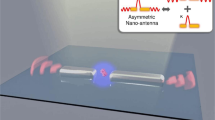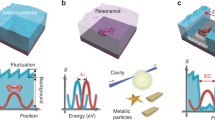Abstract
Owing to the size mismatch between light and nanoscale objects such as single molecules, it is important to be able to control light–molecule interactions1,2,3,4. Plasmonic nanoantennas create highly enhanced local fields when pumped resonantly, leading to increased Raman scattering5, but whether fluorescence enhancement occurs depends upon a variety of factors. Although sharp metal tips6 and colloids7,8 can enhance fluorescence, the highly enhanced optical fields of lithographically fabricated bowtie nanoantennas9 provide a structure that is more controllable and amenable to integration. Using gold bowties, we observe enhancements of a single molecule's fluorescence up to a factor of 1,340, ten times higher than reported previously7,8,10,11,12,13,14,15,16,17,18,19,20,21,22. Electromagnetic simulations reveal that this is a result of greatly enhanced absorption and an increased radiative emission rate, leading to enhancement of the intrinsic quantum efficiency by an estimated factor of nine, despite additional non-radiative ohmic effects. Bowtie nanoantennas thus show great potential for high-contrast selection of single nanoemitters.
This is a preview of subscription content, access via your institution
Access options
Subscribe to this journal
Receive 12 print issues and online access
$209.00 per year
only $17.42 per issue
Buy this article
- Purchase on Springer Link
- Instant access to full article PDF
Prices may be subject to local taxes which are calculated during checkout




Similar content being viewed by others
References
Chance, R. R., Prock, A. & Silbey, R. J. Molecular fluorescence and energy transfer near interfaces. Adv. Chem. Phys. 37, 1–65 (1978).
Muhlschlegel, P., Eisler, H., Martin, O. J. F., Hecht, B. & Pohl, D. W. Resonant optical antennas. Science 308, 1607–1609 (2005).
Fischer, H. & Martin, O. J. P. Engineering the optical reponse of plasmonic nanoantennas. Opt. Express 16, 9144–9154 (2008).
Grober, R. D., Schoelkopf, R. J. & Prober, D. Optical antenna: towards a unity efficiency near-field optical probe. Appl. Phys. Lett. 70, 1354–1356 (1997).
Willets, K. A. & Van Duyne, R. P. Localized surface plasmon resonance spectroscopy and sensing. Annu. Rev. Phys. Chem. 58, 267–297 (2007).
Hamann, H. F., Kuno, M., Gallagher, A. & Nesbitt, D. J. Molecular fluorescence in the vicinity of a nanoscopic probe. J. Chem. Phys. 114, 8596–8609 (2001).
Anger, P., Bharadwaj, P. & Novotny, L. Enhancement and quenching of single-molecule fluorescence. Phys. Rev. Lett. 96, 113002 (2006).
Kuhn, S., Hakanson, U., Rogobete, L. & Sandoghdar, V. Enhancement of single-molecule fluorescence using a gold nanoparticle as an optical nanoantenna. Phys. Rev. Lett. 97, 017402 (2006).
Schuck, P. J., Fromm, D. P., Sundaramurthy, A., Kino, G. S. & Moerner, W. E. Improving the mismatch between light and nanoscale objects with gold bowtie nanoantennas. Phys. Rev. Lett. 94, 017402 (2005).
Farahani, J. N., Pohl, D. W., Eisler, H. & Hecht, B. Single quantum dot coupled to a scanning optical antenna: a tunable superemitter. Phys. Rev. Lett. 95, 017402 (2005).
Farahani, J. N. et al. Bow-tie optical antenna probes for single-emitter scanning near-field optical microscopy. Nanotechnology 18, 125506 (2007).
Tam, F., Goodrich, G. P., Johnson, B. R. & Halas, N. J. Plasmonic enhancement of molecular fluorescence. Nano Lett. 7, 496–501 (2007).
Taminiau, T. H., Stefani, F. D., Segerink, F. B. & van Hulst, N. Optical antennas direct single-molecule emission. Nature Photon. 2, 234–237 (2008).
Zhang, J., Fu, Y., Chowdhury, M. H. & Lakowicz, J. R. Metal-enhanced single-molecule fluorescence on silver particle monomer and dimer: coupling effect between metal particles. Nano Lett. 7, 2101–2107 (2007).
Bakker, R. M. et al. Enhanced localized fluorescence in plasmonic nanoantennae. Appl. Phys. Lett. 92, 043101 (2008).
Muskens, O. L., Giannini, V., Sanchez-Gil, J. A. & Gomez Rivas, J. Strong enhancement of the radiative decay rate of emitters by single plasmonic nanoantennas. Nano Lett. 7, 2871–2875 (2007).
Brolo, A. G. et al. Surface plasmon-quantum dot coupling from arrays of nanoholes. J. Phys. Chem. B 110, 8307–8313 (2006).
Gerard, D. et al. Nanoaperture-enhanced fluorescence: towards higher detection rates with plasmonic metals. Phys. Rev. B 77, 045413 (2008).
Ringler, M. et al. Shaping emission spectra of fluorescent molecules with single plasmonic nanoresonators. Phys. Rev. Lett. 100, 203002 (2008).
Bek, A. et al. Fluorescence enhancement in hot spots of AFM-designed gold nanoparticle sandwiches. Nano Lett. 8, 485–490 (2008).
Song, J. H., Atay, T., Shi, S. F., Urabe, H. & Nurmikko, A. V. Large enhancement of fluorescence efficiency from CdSe/ZnS quantum dots induced by resonant coupling to spatially controlled surface plasmons. Nano Lett. 5, 1557–1561 (2005).
Chen, Y., Munechika, K. & Ginger, D. Dependence of fluorescence intensity on the spectral overlap between fluorophores and plasmon resonant single silver nanoparticles. Nano Lett. 7, 690–696 (2007).
Ruppin, R. Decay of an excited molecule near a small metal sphere. J. Chem. Phys. 76, 1681–1683 (1982).
Rogobete, L., Kaminski, F., Agio, M. & Sandoghdar, V. Design of plasmonic nanoantennae for enhancing spontaneous emission. Opt. Lett. 32, 1623–1625 (2007).
Khurgin, J. B., Sun, G. & Soref, R. A. Practical limits of absorption enhancement near metal nanoparticles. Appl. Phys. Lett. 94, 071103 (2009).
Sun, G., Khurgin, J. B. & Soref, R. A. Practical enhancement of photoluminescence by metal nanoparticles. Appl. Phys. Lett. 94, 101103 (2009).
Palik, E. D. Handbook of Optical Constants (Academic Press, 1985).
Han, M., Dutton, R. W. & Fan, S. Model dispersive media in finite-difference time-domain method with complex-conjugate pole–residue pairs. IEEE Microw. Wireless Comp. Lett. 16, 119–121 (2006).
Lounis, B. & Moerner, W. E. Single photons on demand from a single molecule at room temperature. Nature 407, 491–493 (2000).
Fromm, D. P., Sundaramurthy, A., Schuck, P. J., Kino, G. S. & Moerner, W. E. Gap-dependent optical coupling of single ‘bowtie’ nanoantennas resonant in the visible. Nano Lett. 4, 957–961 (2004).
Acknowledgements
This work was supported in part by National Science Foundation (NSF) grant DMR-0507296 and by Center for Probing the Nanoscale (CPN) through NSF grant PHY-0425897 (W.E.M.) and by an Air Force Office of Scientific Research (AFOSR) Multidisciplinary University Research Initiative (MURI) program no. FA9550-04-1-0437 (S.F.). Work was performed in part at the Stanford Nanofabrication Facility supported by NSF grant ECS-9731293.
Author information
Authors and Affiliations
Contributions
A.K. and W.M. performed experiments and data analysis of experimental data. Z.Y. and S.F. simulated bowtie nanoantennas using FDTD. Y.A. and K.M. synthesized the TPQDI fluorophore.
Corresponding author
Supplementary information
Rights and permissions
About this article
Cite this article
Kinkhabwala, A., Yu, Z., Fan, S. et al. Large single-molecule fluorescence enhancements produced by a bowtie nanoantenna. Nature Photon 3, 654–657 (2009). https://doi.org/10.1038/nphoton.2009.187
Received:
Accepted:
Published:
Issue Date:
DOI: https://doi.org/10.1038/nphoton.2009.187
This article is cited by
-
Extinction Behavior and Near-Field Enhancement of 3D Hybrid Nanostructures Consisting of Ag-Coated SiO2 Nanorods
Plasmonics (2024)
-
Defocused imaging-based quantification of plasmon-induced distortion of single emitter emission
Light: Science & Applications (2023)
-
A comprehensive deep learning method for empirical spectral prediction and its quantitative validation of nano-structured dimers
Scientific Reports (2023)
-
Ultrasensitive lateral-flow assays via plasmonically active antibody-conjugated fluorescent nanoparticles
Nature Biomedical Engineering (2023)
-
Giant cross-Kerr nonlinearity in the metal nanoparticles-graphene nanodisks-quantum dots hybrid system with low light intensity for photovoltaic devices
Applied Physics A (2023)



